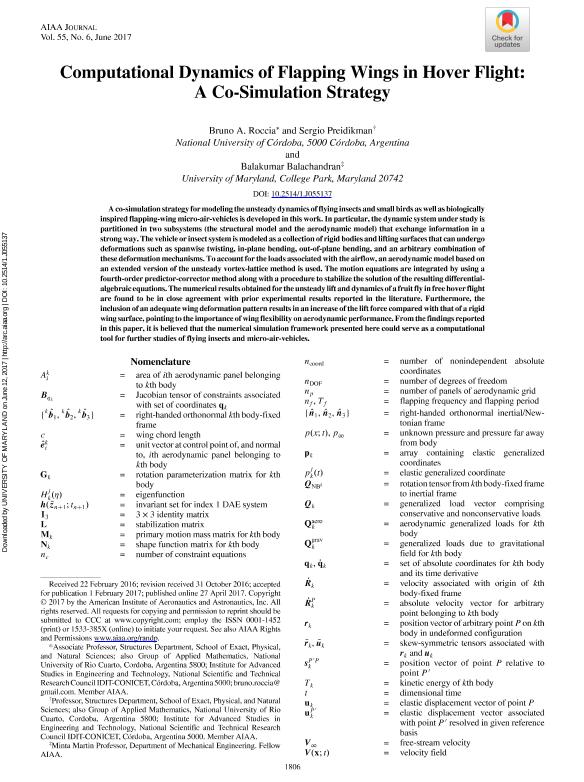Artículo
Computational dynamics of flapping wings in hover flight: A co-simulation strategy
Fecha de publicación:
06/2017
Editorial:
Amer Inst Aeronaut Astronaut
Revista:
Aiaa - American Institute Of Aeronautics And Astronautics
ISSN:
0001-1452
e-ISSN:
1533-385X
Idioma:
Inglés
Tipo de recurso:
Artículo publicado
Clasificación temática:
Resumen
A co-simulation strategy for modeling the unsteady dynamics of flying insects and small birds as well as biologically inspired flapping-wing micro-air-vehicles is developed in this work. In particular, the dynamic system under study is partitioned in two subsystems (the structural model and the aerodynamic model) that exchange information in a strong way. The vehicle or insect system is modeled as a collection of rigid bodies and lifting surfaces that can undergo deformations such as spanwise twisting, in-plane bending, out-of-plane bending, and an arbitrary combination of these deformation mechanisms. To account for the loads associated with the airflow, an aerodynamic model based on an extended version of the unsteady vortex-lattice method is used. The motion equations are integrated by using a fourth-order predictor-corrector method along with a procedure to stabilize the solution of the resulting differential-algebraic equations. The numerical results obtained for the unsteady lift and dynamics of a fruit fly in free hover flight are found to be in close agreement with prior experimental results reported in the literature. Furthermore, the inclusion of an adequate wing deformation pattern results in an increase of the lift force compared with that of a rigid wing surface, pointing to the importance of wing flexibility on aerodynamic performance. From the findings reported in this paper, it is believed that the numerical simulation framework presented here could serve as a computational tool for further studies of flying insects and micro-air-vehicles.
Palabras clave:
Flapping Wings
,
Micro-Air-Vehicles
,
Computational Dynamics
,
Co-Simulation
Archivos asociados
Licencia
Identificadores
Colecciones
Articulos(IDIT)
Articulos de INSTITUTO DE ESTUDIOS AVANZADOS EN INGENIERIA Y TECNOLOGIA
Articulos de INSTITUTO DE ESTUDIOS AVANZADOS EN INGENIERIA Y TECNOLOGIA
Citación
Roccia, Bruno Antonio; Preidikman, Sergio; Balachandran, Balakumar; Computational dynamics of flapping wings in hover flight: A co-simulation strategy; Amer Inst Aeronaut Astronaut; Aiaa - American Institute Of Aeronautics And Astronautics; 55; 6; 6-2017; 1806-1822
Compartir
Altmétricas




